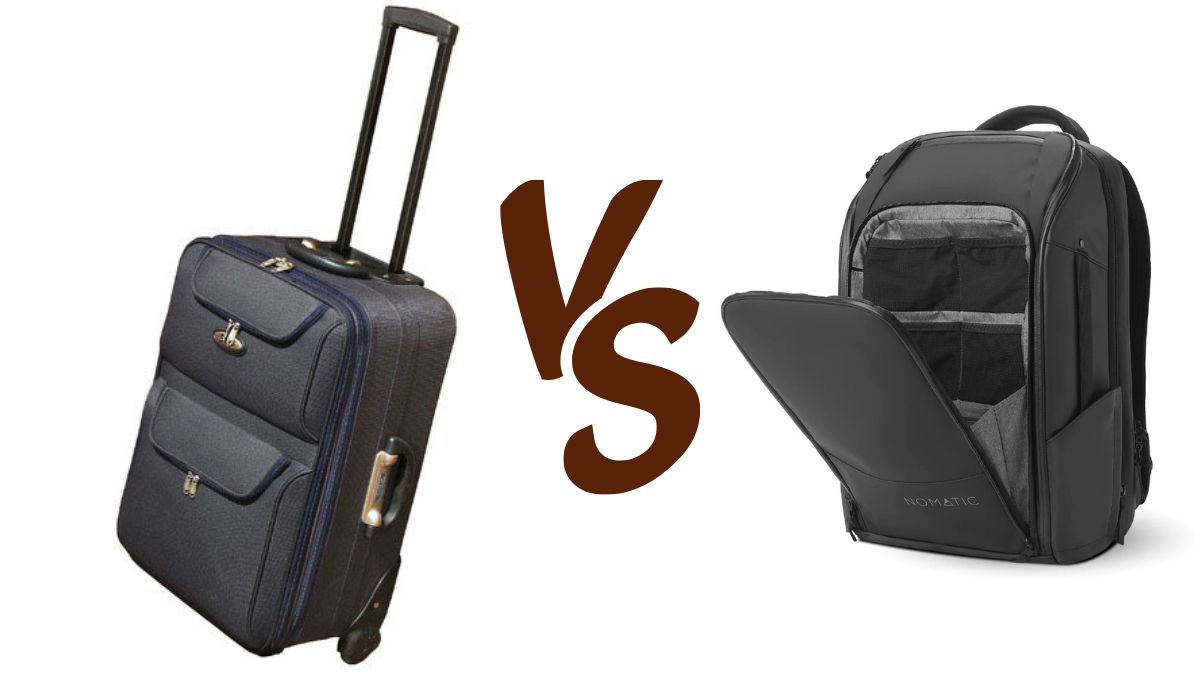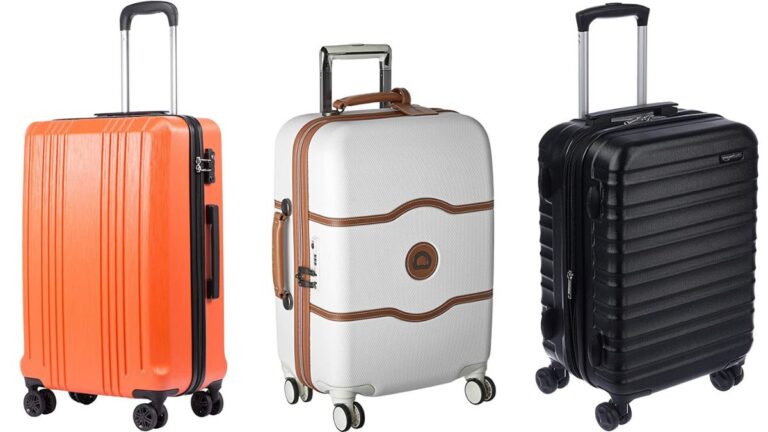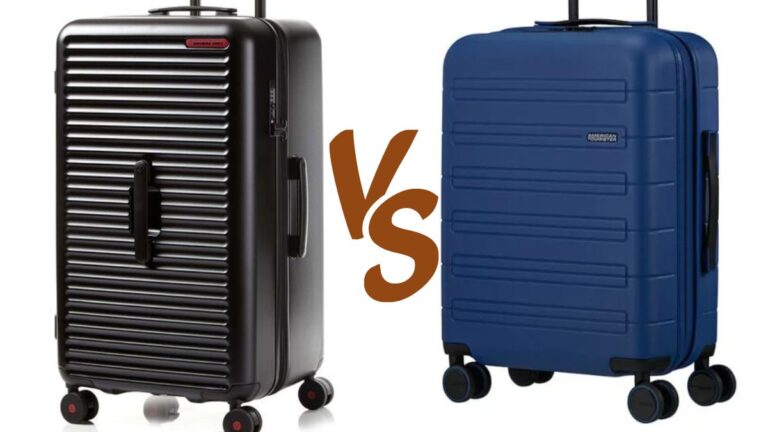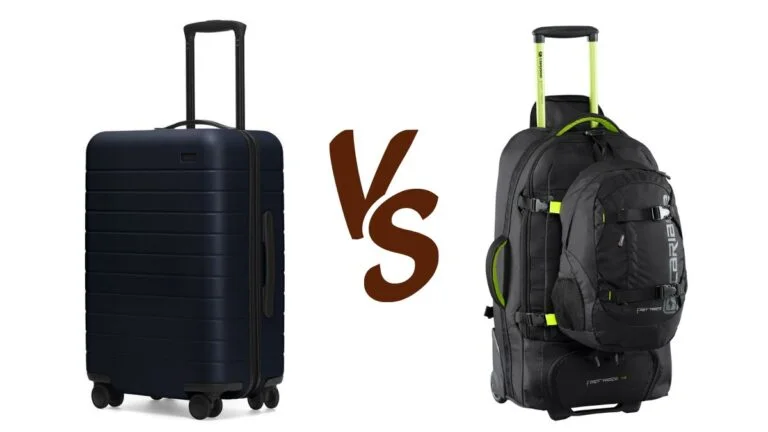Travel Pack Vs. Wheeled Luggage Bag: Comparing Sizes & Uses

As participants in Amazon Associates and other programs, we earn from qualifying purchases. This comes at no additional cost to you. For more details, see our Affiliate Disclosure.
In the world of travel, packing is both an art and a science. When setting off on a journey, whether for a weekend getaway or an extended trip abroad, choosing the right luggage can make all the difference. Travel packs and wheeled luggage bags, each with their own unique strengths and weaknesses, stand as two of the most popular choices among seasoned wanderers.
This article dives into a comparison of these travel companions, analyzing their sizes and optimal uses to help you make the best choice for your next adventure.ž
Best Travel Pack:
MATEIN Extra Large Travel Backpack
- Expandable & Large Capacity: 40L storage, fits overhead and under seat. Ideal for every traveler.
- Convertible Design: Transitions from duffel to briefcase. Hideaway straps. Perfect for frequent flyers.
- Easy to Carry: Lightweight, adjustable straps. Two grab handles. Best travel companion and gift idea.
- Built for Travel: Front pocket for gear, inside pocket with straps. External compression. Dad’s top pick.
- Durable & Lifetime: Water-resistant, sturdy zippers. Survives various temperatures. Perfect traveler gift.
Best Wheeled Luggage Bag
Samsonite Omni PC Hardside Expandable Luggage
- 20″ Spinner Luggage: Meets carry-on size. Great for domestic travel. 4 wheels for ease.
- Dimensions & Weight: Packing: 19″x14.5″x9.5″. Overall: 22″x15″x9.5″. Lightweight at 6.81 lbs.
- 10-Year Warranty: Rigorous testing ensures quality. Covers material and workmanship defects.
- Micro-Diamond Texture: Scratch-resistant poly-carbonate. Maintains beauty trip after trip.
- Side-Mounted TSA Locks: Deters theft. Accessible by you or TSA agents only during travels.
- Oversized Spinner Wheels: Four multi-directional wheels for effortless, lightweight mobility.
- Book Opening Case: Mesh divider, cross straps, and a zipped pocket for organized packing.
- Expansion & Compression: More packing space; keeps clothes neatly pressed during trips.
- Push-Button Handles: Locking mechanism for easy maneuverability; stores inside when idle.
Size Matters: Dimensions and Capacities Compared
When it comes to selecting luggage, size is invariably one of the most crucial aspects to consider. Not only does the size determine how much you can pack, but it also affects how easy your luggage is to transport, store, and even how much you might pay in checked baggage fees. Let’s explore the differences in dimensions and capacities between travel packs and wheeled luggage bags.
Travel Packs
- Typical Size Range: Travel packs can range from small daypacks of about 10 liters to larger options that can hold up to 70 liters or more.
- Flexibility: Unlike rigid suitcases, travel packs can often expand or contract based on the volume of the contents, making them versatile for various trip durations.
- Maximizing Space: Many travel packs come with compression straps that allow you to cinch down your belongings, ensuring everything fits snugly.
Wheeled Luggage Bags
- Typical Size Range: Wheeled bags usually start from cabin-sized options, roughly 20-40 liters, and can go up to 100 liters or more for check-in sizes.
- Rigidity: Most wheeled luggage bags come with a rigid structure, which protects fragile items but means they can’t adjust to fit irregular spaces like overhead bins or car trunks as flexibly as travel packs.
- Compartments and Expansion: Many wheeled bags offer an expandable option, where you can unzip a section to allow for more packing space. Plus, the structured compartments can help with organizing your belongings.
| Criteria | Travel Pack | Wheeled Luggage Bag |
|---|---|---|
| Typical Height | 22 inches (56 cm) | 22 inches (56 cm) |
| Typical Width | 14 inches (36 cm) | 14 inches (36 cm) |
| Typical Depth | 9 inches (23 cm) | 9 inches (23 cm) |
| Capacity Range | 40-70 Liters | 30-80 Liters |
| Expandability | Often expandable | Some models expandable |
| Weight (Empty) | 2-4 lbs (0.9-1.8 kg) | 5-10 lbs (2.3-4.5 kg) |
| Material Thickness | Varies (Often thinner for flexibility) | Varies (Hard cases can be thicker) |
Which Offers More Space?
While the maximum capacities of both types can be comparable, it’s essential to remember that the actual usable space might differ. Travel packs can be more forgiving if you’re trying to squeeze in that extra item. In contrast, wheeled luggage bags, due to their structure, often ensure that items are better organized and protected, especially if you’re carrying breakable goods.
Mobility on the Move: Pros and Cons of Wheels
The freedom to move with ease is an integral aspect of travel. Whether you’re navigating through crowded airports, exploring cobblestone streets, or embarking on outdoor adventures, mobility can significantly affect your overall travel experience. Let’s delve into the advantages and disadvantages of wheels when it comes to luggage, to determine which option might be best suited for your journey.
Advantages of Wheeled Luggage
- Ease of Transport: Simply pull the handle, and you’re on your way. No need to bear the full weight of your luggage, making it ideal for those with back issues or when carrying heavy loads.
- Versatility: Modern wheeled luggage often comes with 360-degree rotating wheels, making navigation in tight spaces, like airplane aisles, more manageable.
- Protection for Your Belongings: The rigid structure that typically accompanies wheeled luggage offers an additional layer of protection for fragile items.
- Professional Appearance: Wheeled luggage often looks more polished and professional, which can be a consideration for business travelers.
Disadvantages of Wheeled Luggage
- Uneven Terrain: Wheels are not friends with cobblestones, gravel, or sandy beaches. In such scenarios, you might find yourself lifting your luggage more than rolling it.
- Weight: The addition of wheels and the associated framework adds to the bag’s overall weight, which could be a concern when adhering to airline weight limits.
- Durability Concerns: Wheels can be vulnerable. If they break or get stuck during your journey, it can cause significant inconvenience.
- Space Consumed: The framework for wheels and the handle mechanism can reduce the actual packing space available inside the luggage.
The Middle Ground – Wheeled Backpacks
For those torn between the convenience of wheels and the adaptability of a backpack, there’s a hybrid option: the wheeled backpack. These offer the best of both worlds, allowing you to roll your luggage when the terrain allows and carry it on your back when necessary.
Backpacking Benefits: Why Some Prefer Travel Packs
Backpacking evokes a sense of adventure, simplicity, and freedom. For many globetrotters, using a travel pack instead of traditional wheeled luggage isn’t just a choice—it’s a way of travel that aligns with their journey’s very essence. Travel packs offer a unique set of benefits that cater to specific needs and types of adventures. Let’s explore why some travelers steadfastly prefer backpacks over their wheeled counterparts.
Versatility in Varied Terrains: Unlike wheeled luggage, travel packs are designed to be carried comfortably on your back. This makes them ideal for navigating uneven terrains like cobbled streets, hiking trails, or crowded urban environments where wheels might become a hindrance.
Hands-Free Mobility: With a backpack, your hands are free to hold a map, snap photos, or grab a quick snack. This freedom enhances the travel experience, especially when exploring new places.
Compactness and Flexibility: Travel packs tend to be more malleable than hard-shell wheeled luggage. This flexibility allows for easier storage in varied spaces, be it overhead compartments, under bus seats, or even in shared accommodations where space might be limited.
Encourages Minimalist Packing: Given the need to carry it on your back, travel packs often prompt travelers to pack only the essentials. This minimalist approach not only lightens the load but also simplifies the travel experience.
Quick Movement: Navigating through busy airports, hopping on and off trains, or making a quick transfer is often smoother with a backpack. Without the need to drag or wheel luggage, travelers can move more swiftly.
Cultural Connection: In many parts of the world, especially popular backpacking destinations, carrying a travel pack can make one feel more integrated with the local traveler community. It can also serve as an icebreaker or conversation starter with fellow backpackers.
Durability: Without external components like wheels or handles that can break, travel packs, especially those made for trekking, are often designed to withstand rough handling and harsh conditions.
For those who value adaptability, freedom of movement, and a more intimate connection to their surroundings, the benefits of backpacking make travel packs an enduring favorite.
Materials and Durability: Which Lasts Longer?
The longevity of luggage is a primary concern for travelers, particularly for those who are frequently on the move. Whether it’s a wheeled suitcase being tossed onto a conveyor belt or a travel pack being strapped to a dusty bus roof, durability is paramount. A significant factor that influences this durability is the material used. Let’s delve into the materials commonly found in both travel packs and wheeled luggage bags, comparing their resilience and lifespan.
Travel Packs Materials
- Nylon & Ripstop Nylon: Lightweight and strong, nylon is often reinforced in travel packs as ‘ripstop’ to prevent tears from enlarging. Its tight weave makes it resistant to water and wear.
- Polyester: Generally cheaper than nylon, polyester is used in budget-friendly travel packs. While it’s reasonably durable, it might not withstand extreme conditions as well as other materials.
- Canvas: Often found in vintage or retro-style backpacks, canvas is robust and offers a unique aesthetic. However, it’s heavier and might require treatment for water resistance.
Wheeled Luggage Materials
- Polycarbonate: Used in many hard-shell suitcases, polycarbonate is lightweight yet impressively durable. It can absorb impact, returning to its original shape after being deformed.
- ABS (Acrylonitrile Butadiene Styrene): Another common material for hard-shell cases, ABS is lighter than polycarbonate but is generally less resistant to impacts.
- Ballistic Nylon: Originally developed for military use, this is one of the toughest fabrics. It’s tear and abrasion-resistant, making it ideal for high-end soft-sided wheeled luggage.
- Leather: Offering a classic and elegant look, leather wheeled bags are durable, but they require regular maintenance to retain their appearance and prevent drying or cracking.
Durability Factors Beyond Material
- Zippers: Metal zippers, especially those with larger teeth, tend to be more durable than plastic ones.
- Stitching: Double or reinforced stitching at stress points can significantly increase a bag’s lifespan.
- Wheels & Handles: The quality and build of wheels and handles can influence the longevity of wheeled luggage. Recessed wheels and reinforced handles are less prone to breakage.
While materials play a crucial role in determining durability, the construction quality and care taken during usage can also impact a bag’s lifespan. Both travel packs and wheeled luggage come in durable options, but the ultimate longevity will depend on a combination of material, craftsmanship, and user treatment. When investing in luggage, it’s worthwhile to prioritize quality, even if it comes at a slightly higher price point, to ensure longevity and reliability in your travels.
Accessibility and Organization: Pockets, Compartments, and More
In the dynamic world of travel, where every moment counts, easy access to essentials and effective organization can transform your experience. From searching for your passport at a busy airport to grabbing your camera for a spontaneous shot, how your luggage caters to your accessibility and organizational needs can make a world of difference. Let’s explore how travel packs and wheeled luggage bags compare in these domains.
Travel Packs
- Top and Front Loading: While traditional backpacks are often top-loading, many travel-specific packs feature front or panel loading, which allows for easier access to items without unpacking everything.
- Multiple Compartments: Modern travel packs come equipped with various compartments, from padded laptop sleeves to separate sections for footwear, ensuring each item has its place.
- Mesh Pockets: Often found on the exterior, these are handy for items you need to grab quickly, like water bottles or umbrellas.
- Compression Straps: While primarily for reducing volume, these straps can also be used to secure items like tripods or sleeping pads externally.
- Hidden Pockets: Some travel packs feature concealed pockets, perfect for stashing valuables or essential documents for added security.
Wheeled Luggage Bags
- Main Compartment: The primary compartment in wheeled bags is usually vast, allowing for the bulk of your items. Many come with straps to secure contents and prevent them from moving during transit.
- Organizational Pockets: Soft-sided wheeled bags often feature front pockets for easy access to items like travel documents, reading materials, or electronics.
- Expandability: Several wheeled bags offer an expandable zipper, providing additional packing space when needed and helping in organization.
- Dividers and Compartments: Hard-shell wheeled luggage typically includes internal dividers, making it easier to separate and organize different types of items, from clothing to toiletries.
- Lockable Zippers: For added security, many wheeled bags come with lockable zippers or integrated TSA locks.
Which Offers Better Accessibility and Organization?
The answer often lies in the traveler’s individual needs:
- Short Trips: Wheeled luggage, with its broad main compartment, is often sufficient for shorter jaunts where extensive organization might not be necessary.
- Extended Travels or Varied Activities: A travel pack, with its plethora of pockets and compartments, might prove more beneficial when packing for diverse needs over longer durations.
Air Travel Considerations: Dealing with Airlines and Overheads
Navigating air travel is often a delicate dance of managing luggage sizes, airline regulations, and overhead bin battles. While the romance of flying might center on the destination, the practicalities of the journey often revolve around our baggage choices.
When it comes to travel packs versus wheeled luggage, several considerations come into play for the frequent flyer. Let’s unravel the intricacies of both options in the world of air travel.
Travel Packs
- Flexibility in Size: Soft-sided travel packs can be squished or compressed to fit into tight overhead spaces or even under the seat, making them versatile for varying airplane configurations.
- Hands-Free Transit: Speeding through airport terminals or juggling tickets, passports, and snacks becomes easier when your main luggage is comfortably strapped to your back.
- Avoiding Damage: Without external components like wheels or handles, travel packs might be less prone to damage if they do end up being checked in.
- Weight Distribution: Carrying weight on your back can be less straining for long airport walks than dragging a wheeled bag, especially if the airport lacks smooth surfaces.
Wheeled Luggage Bags
- Defined Structure: Many wheeled bags are designed with airline specifications in mind, ensuring they fit into overhead bins when adhering to size guidelines.
- Ease on Flat Surfaces: On the smooth terrains of airports, wheels are king. Gliding through vast terminals without bearing weight offers undeniable comfort.
- Protection for Fragile Items: Hard-shell wheeled luggage offers a layer of protection for electronics, souvenirs, or other delicate items.
- Professional Appearance: For business travelers, a sleek wheeled suitcase can give a more professional impression.
General Air Travel Tips
- Stay Updated: Airline regulations regarding carry-on sizes and weights change frequently. Always check the specific airline’s requirements before flying.
- Prepare for the Unexpected: Flights can be overbooked, or overhead spaces can fill up quickly. Be prepared for the possibility of having to check your luggage, and keep essential items in a smaller personal bag.
- Invest in Quality: Whether choosing a travel pack or wheeled luggage, investing in high-quality luggage that can withstand the rigors of air travel will pay off in the long run.
Adventures Off the Beaten Path: Which Fares Better?
When travel beckons beyond the manicured streets of urban destinations and into the rugged terrains, dense forests, or remote villages, your choice of luggage becomes more than just a matter of convenience.
It’s about adaptability, resilience, and even safety. Adventures off the beaten path demand gear that’s up to the task. So, between the travel pack and the wheeled luggage bag, which is the better companion for unconventional escapades?
Travel Packs
- Versatility in Varied Terrains: With uneven paths, muddy trails, or sandy landscapes, carrying a travel pack on your back is often more manageable than dragging wheeled luggage.
- Balance and Mobility: Especially in challenging terrains, having the weight distributed on your back allows for better balance, crucial when hiking or navigating slippery areas.
- Blend in with the Crowd: In many remote destinations, locals use backpacks or similar carrying methods. Using a travel pack can help you blend in, rather than standing out as a tourist with a wheeled suitcase.
- Adaptability: Travel packs are often designed with outdoor adventures in mind, featuring water-resistant materials, multiple gear loops, and compatibility with hydration systems.
Wheeled Luggage Bags
- Limited Off-road Ability: Wheels, especially those not designed for rugged terrains, can become a hindrance. Cobblestones, sand, or forest trails can render them almost useless.
- Durability Concerns: While many wheeled bags are robust, their wheels and handles can become points of vulnerability in harsh conditions.
- Weight Distribution: On uneven paths, dragging a wheeled bag can strain one side of the body, possibly leading to discomfort or even injury.
- Space Utilization: The structure needed for wheels and handles can reduce the usable space in your luggage, which might be a concern for those carrying camping or adventure gear.
Middle Ground – Wheeled Backpacks
For those uncertain about leaving wheels behind entirely, there’s the hybrid wheeled backpack. These combine the comfort of a backpack with the convenience of wheels, though they might not be as rugged as dedicated travel packs.
For true adventures off the beaten path, where the landscape’s unpredictability is part of the allure, travel packs generally fare better. Their design and functionality align more closely with the demands of unconventional terrains and unexpected challenges. While wheeled luggage has its strengths, it’s best suited for smoother terrains and more structured travel scenarios. When venturing into the wild, it’s wise to choose gear that complements the journey’s spirit and challenges.
Price Points: Investing in Quality vs. Sticking to a Budget
Travel gear, much like travel itself, can range from budget-friendly to luxury, and understanding the trade-offs between cost and quality is crucial. The price of luggage, be it travel packs or wheeled luggage, can vary based on materials, brand reputation, design innovation, and durability features. Let’s dissect the considerations you should weigh when deciding between investing in high-quality luggage or sticking to a budget-friendly option.
Investing in Quality
- Longevity: Higher-quality bags are usually designed to withstand the rigors of frequent travel. With robust materials and superior craftsmanship, these bags often last much longer, offering better value over time.
- Innovative Features: Premium luggage often comes with advanced features such as built-in GPS trackers, ergonomic designs, or specialized compartments for tech gear.
- Warranty and Repairs: Renowned brands that offer high-quality luggage often provide extensive warranties, ensuring peace of mind for travelers.
- Aesthetics and Prestige: Premium luggage can be a style statement, reflecting a certain standard and aesthetic appeal that budget options might not offer.
Sticking to a Budget
- Immediate Savings: Opting for budget-friendly luggage means more immediate savings, which could be channeled into the travel experience itself.
- Replaceability: Less expensive bags can be easily replaced if they get damaged or lost, without significant financial strain.
- Suitable for Infrequent Travel: If you’re not a frequent traveler, a budget-friendly option might serve the purpose without the need for a hefty investment.
- Trends and Variability: Budget options allow you to change luggage more frequently, aligning with changing styles or needs.
Consider the Middle Ground
There’s a vast market segment between the high-end and budget options, offering a balanced mix of quality and affordability. These mid-range options can often provide the durability and features of premium brands without the hefty price tag.
Care and Maintenance: Keeping Your Luggage in Top Shape
Whether you’ve invested in a high-end travel pack or chosen a budget-friendly wheeled luggage bag, proper care and maintenance can extend its life and keep it looking and functioning well.
Different materials and components require different care routines, but there are general guidelines that can help you maintain your luggage. Below, we’ll explore some of the common practices that can be applied to both types of luggage to keep them in top shape.
General Cleaning Tips:
- Regular Dusting: Use a soft brush or cloth to remove surface dust and dirt after each trip.
- Spot Cleaning: For small stains, use a damp cloth with mild detergent, and gently rub the affected area.
- Deep Cleaning: For larger stains or overall cleaning, refer to the manufacturer’s guidelines, as different materials may require specific cleaning agents.
- Air Drying: Allow the luggage to dry completely in a well-ventilated area, away from direct sunlight, to prevent mildew and fading.
Travel Packs:
- Check for Tears: Regularly inspect seams and fabric for signs of wear or tearing, and consider professional repair if needed.
- Handle Zippers with Care: Keep zippers clean and lubricate them occasionally with zipper lubricant or wax to ensure smooth operation.
- Waterproofing: If your travel pack isn’t waterproof, consider using a waterproofing spray suitable for the fabric type.
Wheeled Luggage Bags:
- Wheel Maintenance: Keep the wheels free of dirt and debris, and lubricate them if they become squeaky or stiff.
- Handle Care: Regularly check telescoping handles for looseness and tighten any visible screws.
- Protecting the Shell: For hard-shell cases, use a gentle cleaner suitable for the material (polycarbonate, ABS, etc.), and avoid abrasive scrubbers.
Storage Guidelines:
- Keep Dry and Clean: Store luggage in a dry, clean place, away from extreme temperatures and humidity.
- Avoid Overpacking: Storing bags overstuffed can lead to deformities. Keep them lightly packed or empty.
- Use Protective Covers: If available, use the protective covers that often come with the luggage to keep it free from dust and scratches.
Luggage, whether travel packs or wheeled bags, is an integral part of travel, and taking proper care of it ensures that it remains a reliable companion for your journeys. By adhering to these care and maintenance practices and following any specific guidelines provided by the manufacturer, you can enhance the lifespan and performance of your luggage, making every trip a bit smoother and more enjoyable.
Travel Pack Vs. Wheeled Luggage Bag: Which One Is Right For You?
The timeless debate between a travel pack and a wheeled luggage bag isn’t solely about aesthetic appeal but dives deep into one’s travel persona, understanding how you move, where you go, and what makes your journey seamless. With each having its unique advantages and challenges, your perfect travel companion might just be waiting in the insights below.
Your travel style and frequency play a significant role in this decision. If you’re someone who thrives on backpacking or trekking through lesser-known terrains, the flexibility and adaptability of a travel pack might resonate more with your spirit. On the other hand, for those who jet-set for business meetings or relish luxury travels, the sophistication and structured appeal of wheeled luggage bags might be more apt. Additionally, frequent travelers might lean towards durability and specialized features, while occasional holiday-goers might prioritize ease of use over intricate design.
Delving into personal preferences and physical considerations, comfort is paramount. Those who cherish mobility, love the feel of a bag snug against their back, and value the freedom of having their hands unoccupied might find solace in travel packs. However, for individuals who’d rather avoid the strain of carrying weight or have certain back-related health concerns, wheeled luggage offers the convenience of effortless movement.
An often-underestimated aspect of choosing luggage is its organization potential. While wheeled bags might give you a segmented and structured packing space, travel packs often provide a blend of open interiors and multiple external pockets, catering to a more flexible packing style.
The very nature of your destinations also nudges you towards one of these options. Urban settings with their smooth pathways, elevators, and plush hotel lobbies could make wheeled luggage an obvious choice. Contrastingly, if you’re venturing into rural landscapes or areas with uneven terrains, a travel pack offers unmatched versatility.
Furthermore, weather plays its part too; frequent travelers to regions with unpredictable weather might prefer the ruggedness of a travel pack or the protective shield of a hard-shell wheeled bag.
Lastly, budget and long-term value enter the fray. With a vast spectrum spanning from budget options to luxury segments in both categories, it’s about understanding whether you’re seeking a temporary solution or a long-term travel partner. Some might view their luggage as a long-term investment, warranting a higher upfront cost for durability and brand reliability, while others might seek budget-friendly options for sporadic travels.
In conclusion, the balance between a travel pack and wheeled luggage bag pivots on your individual needs, aspirations, and travel patterns. By aligning these with the inherent features of each type, your journey can be enhanced, whether you’re gliding effortlessly through metropolis avenues or venturing through remote landscapes with a pack as your trusted ally. Whatever you choose, let it be an extension of your travel spirit, enhancing each journey you undertake.









